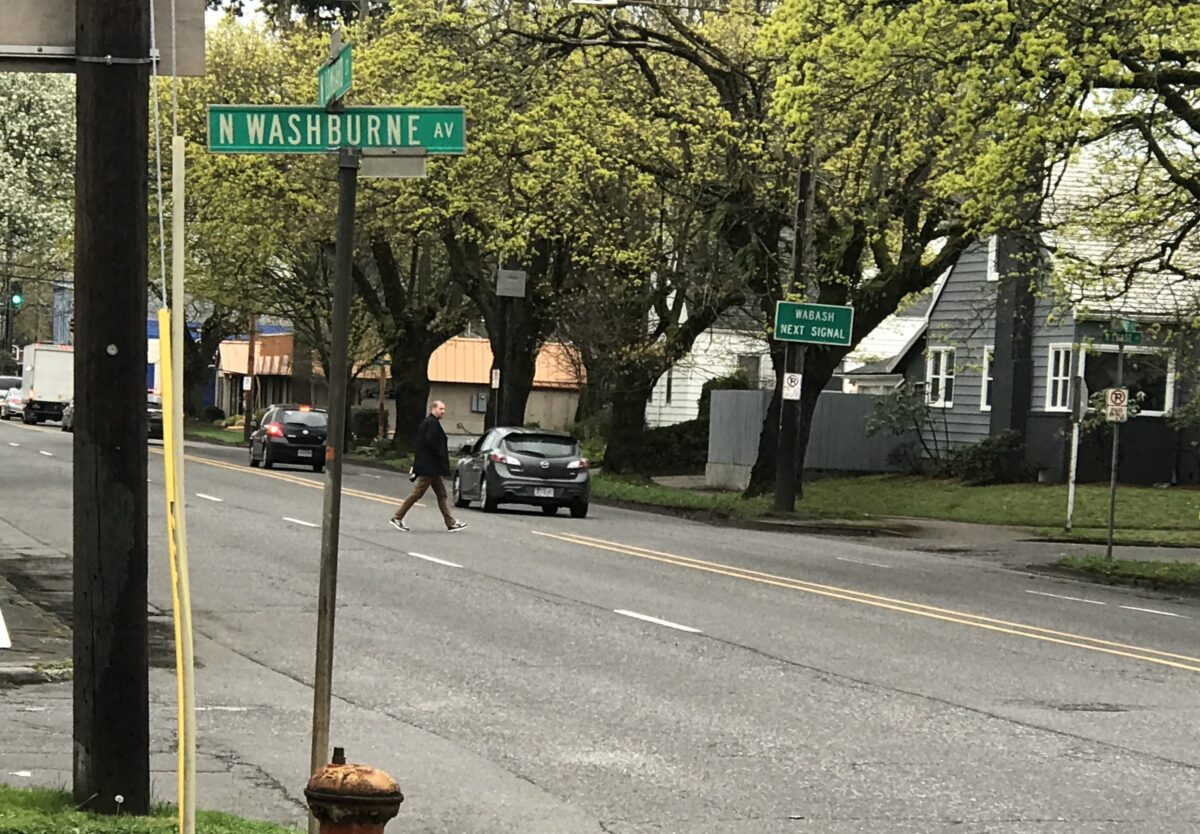
“You’ve got a major freight street here, and again, major freight streets are being turned into multimodal parkways. I don’t understand that.”
— Portland Freight Committee member
I found myself in the rare position of rooting for the Oregon Department of Transportation (ODOT) during the monthly meeting of the Portland Freight Committee on November 7th.
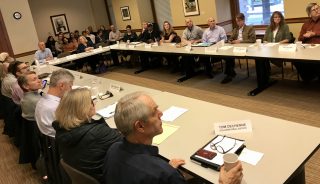
(Photo: J. Maus/BikePortland)
Under fire from a relatively hostile crowd for a project that aims to improve safety through a reduction in driving capacity and new bike lanes on a major freight route, ODOT staffers admirably defended biking and walking.
The PFC, considered to be the most powerful of the City of Portland’s three modal committees (mostly because its members are from major corporations who pay them to attend, unlike the biking and walking committees which are made up of volunteers), heard a presentation on the Lombard Multimodal Safety Project from ODOT staffer Jennifer Bachman.
ODOT’s project will redesign 1.4 miles (25 blocks) of the road between North Fiske and Boston. The PFC was listening closely because — in addition to being an important neighborhood street full of popular stores and restaurants — Lombard also functions as U.S. Route 30 and is a key freight route.
In order to improve safety, ODOT plans to reduce the amount of lanes for driving and add bike lanes in both directions. The current cross-section consists of four multi-purpose lanes and a parking lane. The new cross-section will have three multi-purpose lanes (two for through traffic, one turning) and two bike-only lanes. The project will also add two new crossing treatments with medians and rapid-flashing beacons at Emerald and Burrage (they considered two other crossings at Newman and Washburne but studies showed too few people crossing to warrant the treatment).
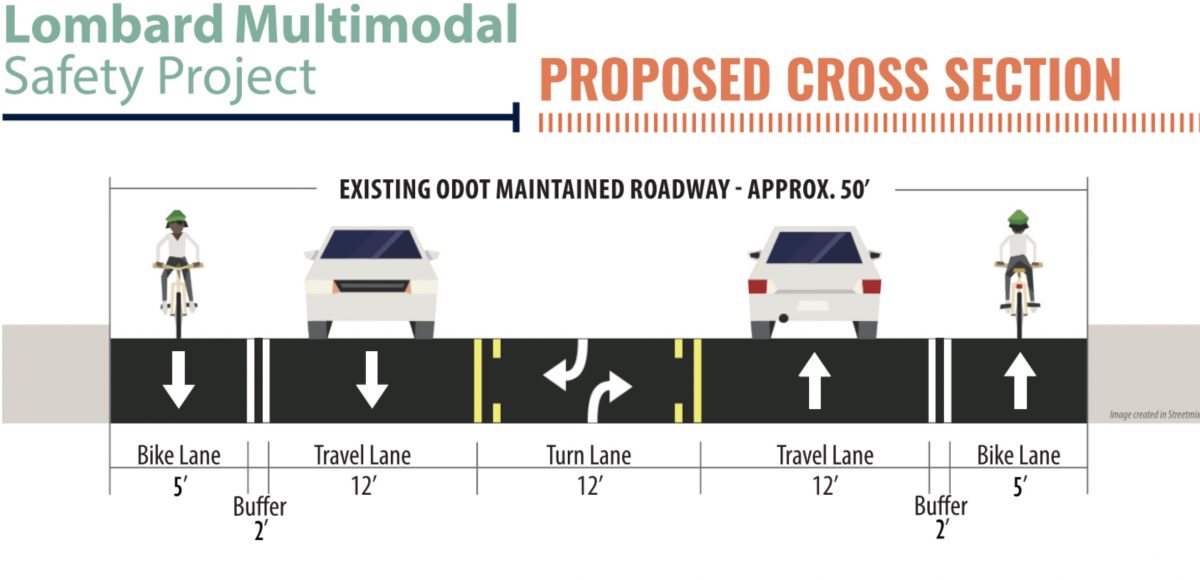
Advertisement
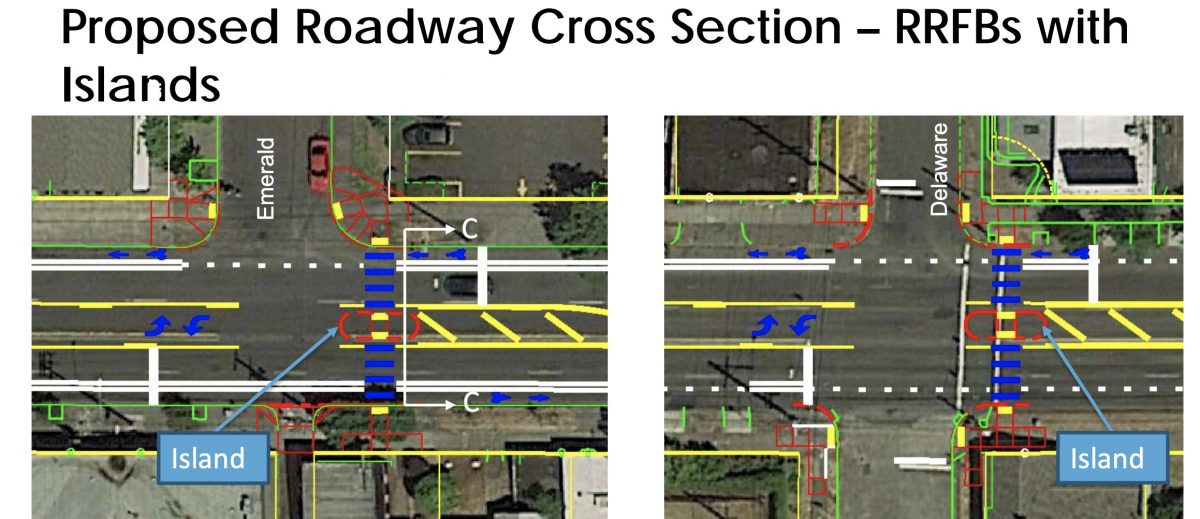
ODOT will also add two sections of mountable traffic separators at Burrage and Villard (see graphic).
According to ODOT’s Safety Priority Index System (SPIS) database, this stretch of Lombard is in the top 1% of all locations statewide. There have been 200 crashes in the past five years and about one crash ever 9-11 days on average — over half of which lead to injuries.
Despite those good intentions, ODOT heard worries that the lane reconfigurations would negatively impact freight hauling.
Oregon Trucking Association President Jana Jarvis expressed concern that the project would reduce freight capacity. “We’re talking about adding bicycle lanes, and sometimes those things conflict,” Jarvis pointed out. The ODOT rep assured Jarvis that the project only re-stripes existing lanes and doesn’t reduce any existing overhead or curb-to-curb width. “We’re not creating any new pinchpoints,” added ODOT trucking expert Tony Coleman. “What you can go through today, you’ll be able to go through after the project is completed.”
But those assurances didn’t seem to be enough for some freight committee members.
“You’re reducing carrying capacity by 50%,” said one distressed committee member (whose name I didn’t get). “That is still a reduction right? You’ve got a major freight street here, and again, major freight streets are being turned into multimodal parkways. I don’t understand that.”
Advertisement
Jarvis also repeated the capacity concern. “But you are reducing a lane,” she said. “Yes,” Bachman replied, “We are reducing through capacity a little bit, but it’s not a 50% reduction like you might think in going from four to two lanes. It’s in the neighborhood of about a 20% reduction in traffic capacity, well within what our model allows.”
“This is a safety project. We are making sure freight isn’t hindered. But this really is a safety project.”
— Jennifer Bachman, ODOT
Rebuffed on the capacity concerns, one member of the committee then asked, “But is [the street] functioning as fast? That matters.”
Committee Chair Pia Welch with FedEx added, “Since we’re a freight group, how is this project improving the movement of goods?”
ODOT’s Coleman challenged the skeptics by reminding them that this project will have the exact cross-section ODOT has already implemented west of Fiske. “Show us the difference it’s made over the years as we’ve put these features in,” he offered to the naysayers. “We feel this project maintains freight capacity and we’re still meeting the needs of pedestrians.”
“This is a safety project,” Bachman added. “We are making sure freight isn’t hindered. But this really is a safety project.”
Another member (didn’t get his name) wondered if bike lanes on freight routes were the new normal for ODOT. “I’m just wondering why we need two bike lanes?” he asked.
Then, in an attempt to remove them altogether, several members expressed skepticism about the bike lanes not having any physical protection. Corky Collier with the Columbia Corridor Association wanted to know if ODOT did any analysis to ensure the lanes would improve safety. “If I’m going to put a bike lane in a relatively dangerous place, maybe I would put that one block over,” he said.
Advertisement
Jarvis added that she feels when bike riders are next to truck operators, there should be more separation. “This seems counter-intuitive,” Jarvis said. “And I agree with Corky, there should have been an analysis of where the most appropriate road was for cyclists, because this is not it.”
Another member said she’s concerned that the removal of the parking lane will take a way a buffer that makes crossing the street safer.
“There should have been an analysis of where the most appropriate road was for cyclists, because this is not it.”
— Jana Jarvis, Oregon Trucking Association
Through all of this, ODOT’s Bachman stood up admirably for the bike lanes and other changes. “This is a multimodal safety project and the movement going forward is to bring in that multimodal aspect — which was something decided at a much higher pay grade than mine. So that’s the project. We’re improving connectivity.” As for the claim that the parking lane made crossing safer? “Clearing out the parking provides better visibility for pedestrians and vehicles can see each other better too,” Bachman said.
The only freight committee member who spoke up for the project was TriMet Senior Planner Jeff Owen. “This striping is helpful for our bus operators because it makes the road more organized,” he said. “From our perspective, this should be a big improvement.”
Committee Chair Welch said the concerns brought up at the meeting were “very good feedback” and she said they need to take a closer look at the design. The PFC plans to draft a letter with their concerns and send it to ODOT.
The project is well into the design phase. Final plans are expected by July 2020 and construction should be completed by 2022.
— Jonathan Maus: (503) 706-8804, @jonathan_maus on Twitter and jonathan@bikeportland.org
— Get our headlines delivered to your inbox.
— Support this independent community media outlet with a one-time contribution or monthly subscription.


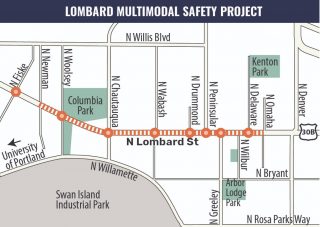
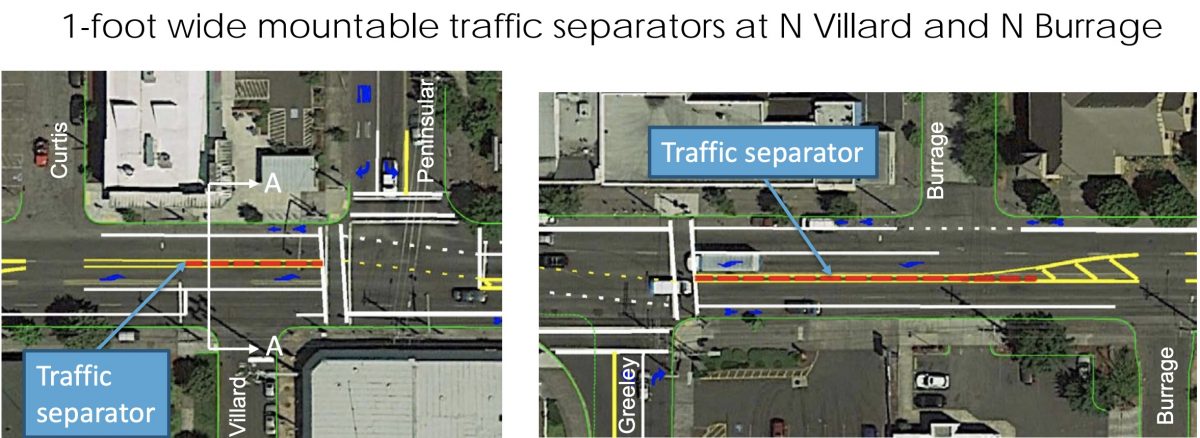
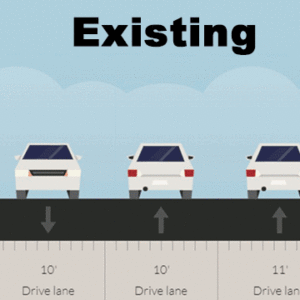
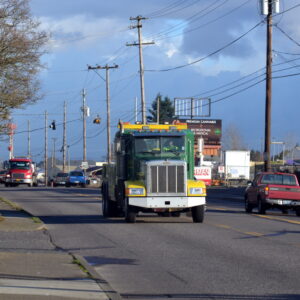
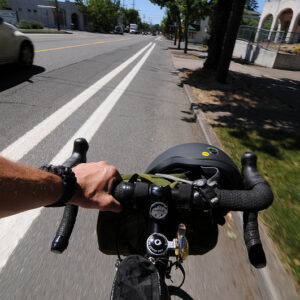
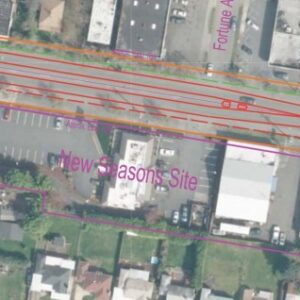
Thanks for reading.
BikePortland has served this community with independent community journalism since 2005. We rely on subscriptions from readers like you to survive. Your financial support is vital in keeping this valuable resource alive and well.
Please subscribe today to strengthen and expand our work.
As a way too frequent driver of this stretch, I couldn’t disagree more with the idea that this a major freight route. However, to placate the OTA, maybe it is finally time to build the flyover on Columbia Blvd over the railroad tracks near the wastewater treatment plant.
with what money source for a flyover ?
Yeah, that assertion baffles me. Columbia is not only better suited for freight, it’s faster and has better access to I-5. I guess there could be better Columbia-to-Lombard connections, especially in St Johns. Judging by the other vehicles on my (sadly car-centric) commute, the lack of those connections doesn’t seem to make Lombard more appealing.
I think that US 30 should be rerouted away from Lombard, which is a residential and retail thoroughfare – it should never have been considered a freight route. I agree that it is past time to separate the grades for road and rail on Columbia Blvd, however, if they do that, the should also provide a way for those who live and go to school north of Columbia Blvd to cross safely, preferably by capping/burying Columbia Boulevard between N Portland Road and N Banks St. The trucking companies and the railroads can pay.
News flash PFC! People live there, and their lives are more important than an inefficient and indulgent freight industry’s bottom line.
Exactly. Maybe PFC members can “pass the hat” and buy up all the Real Estate on Lombard from MLK to the St. John’s Bridge. Assuming they can’t afford to do that (and they can’t) they’re going to have to accept that keeping vulnerable people who live/work/recreate on this stretch safe is more important that trucks operating on this particular street.
Accepting unsafe conditions for people who live/work in this area because PFC members would rather not detour to controlled access highways like I-84 shouldn’t be an ODOT policy position; glad to see ODOT pushed back.
PFC members would happily mow down every adjacent house on the route, if it meant freight could move a few minutes faster. They don’t care about our city.
Jonathan – thank you so much for the detailed reporting. I’ve got a honest question that’s been nagging me though: why is it, when designing these new complete-repaintings, does ODOT/PBOT default to doing a painted bike lane on either side rather than a fully-separated bidirectional lane? I thought from things like https://usa.streetsblog.org/2019/05/29/protect-yourself-separated-bike-lanes-means-safer-streets-study-says/ it had been adjudicated that painted bike lanes were no safer than no bike lane at all, but PBLs are much more favorable in terms of a safety & comfort boost (especially around big trucks like this). Is there a reason we stick to just paint? Seems the cost & size is around the same.
Lots of reasons! But I think it’s mostly that the political leadership and engineering capacity/urgency just isn’t there yet. At least not on projects like this. ODOT (or PBOT in some cases) comes into a “safety” project like this and assumes that getting the lane reconfiguration and removing the on-street parking is all the political lift they can handle. To do physical protection of the bike lane – especially a bi-directional one – requires a much greater amount of analysis/process/leadership/vision/guts. Therefore it doesn’t get done because it’s too hard. Instead they go for the new cross-section and consider that a step in the right direction and usually bike advocates don’t squawk and often will call it a “win” so the cycle continues.
“and usually bike advocates don’t squawk and often will call it a “win” so the cycle continues.”
And the results speak for themselves:
2014 — 7.2%
2015 — 7.0%
2016 — 6.3%
2017 — 6.3%
2018 — 5.3%
In addition to the perfectly valid reasons Jonathan gave, there are traffic and civil engineering reasons as well. For truck traffic, bike lanes create an extra “wiggle” space for wide loads and wide turning radii, as long as the bike lanes are not fully protected. For car traffic, bike lanes corral cars into the center of the roadway which is typically stronger in construction and more wear-resistant, and away from the curbs where the roadway is weakest but most expensive to repair or replace. The bike lanes also provide a buffer between motor vehicles and pedestrians.
Of course, regular bike lanes on busy and/or fast roadways are not really for bicyclists, they are for motor vehicles for the above reasons. A normal bike lane, even with a buffer, ought to be on a street where the 85th percentile of traffic is under 30 mph, preferably 25, which Lombard I’m guessing is not.
I’m not so sure a bi-directional bike lane on one side of the street in such a busy area, commercial district with lots of driveways and side streets, solves more problems than it creates – in terms of safety of cyclists and ease of use for bikers – especially those accessing all the side streets and businesses along the corridor. Perhaps if it was the rule (like in some European cities) and not the exception, as it would be in Portland as a design one-off, it might work. There are still many issues with this bi-directional design – save it for the MUPs and bike paths out along the river or green-space.
@PFC: What is more important to you — human lives or the movement of goods?
But is [the street] functioning as fast? That matters.”
Committee Chair Pia Welch with FedEx added, “Since we’re a freight group, how is this project improving the movement of goods?”
The movement of goods. Clearly.
I hope the PFC members never have to experience the loss of a loved one to traffic violence.
I find myself agreeing with some of the freight folks. These bike lanes should definitely have some separation to protect them from the freight. Preferably with concrete barriers.
Sad to say, but these day I’d rather ride in an unprotected bike lane on a freight-only street (with supposedly professional drivers) over riding in an unprotected lane with distracted/drugged/drunk car drivers. Oh wait, that’s all of Portland. I guess we need barriers on all the bike lanes then, it’s about time!
I agree Karstan. We definitely need physical protection here. But keep in mind that it’s very obvious to me that they were simply concern-trolling… Since every person who said they wanted protection for the bike riders also said they wanted the bike lanes on a different street. These folks know what they’re doing: By saying “The bike lanes must be protected” they think they’ll force ODOT to say, “Well there’s not enough room for protected bike lanes” to which PFC will be able to say “Gosh darn it, that’s too bad. Guess they’ll just have to go somewhere else.” The voila! No more bike lanes. See how that works?
Or they narrow the traffic and turn lanes to 10 feet each, as proscribed by federal guidelines for such streets to get drivers to drive at the posted speed limit, and use the saved 6 feet for buffering and those little white magic wands that cities and states like so much.
I think this illustrates the lack of integrity and ethics to argue that freight takes priority over human beings. These are the ‘freight’ leaders with pay to play sway in Portland Transport Planning. This ‘regional’ freight committee should be chaired by an impartial administrator at Metro. Metro manages all the other regional committees. They should manage the freight committee. Obviously PBOT, in the past, has been unduly swayed by commercial interests favoring profit and speed over people’s lives. Where’s the moral imperative Janis? Remember this is the same group that helped organize the angry gun toting loggers that forced a Senate shut down.
Why is this not being highlighted more? I would like to see this slip into the mainstream conversation in the form of an investigative piece in the Oregonian or Willamette Week. Someone needs to do some digging. I have been told that this is easily one of the most powerful, or at least influential political entities in Portland, which is really frightening.
To paraphrase Jana Jarvis,
“There should have been an analysis of where the most appropriate road was for trucks , because this is not it.”
Lombard through the heart of the St Johns Business and residential district is no longer the same place that it was in 1969. Turn em left and put em on Columbia.
this is exciting! but, i’m also skeptical. i live just a few blocks south of this (and first i’ve heard of the project). i can’t wait to see it all unfold…but, honestly, i’ll likely still keep biking willamette to get west (because outside of this improved stretch, i absolutely do not want to bike on lombard). what i am most excited about are safer pedestrian crossings across lombard!!
To the freight committee Dutch Savage is still battling Jimmy Snuka at the Portland Wrestling Arena on Fessenden above Sandy Barr’s Flea Market and only Dock Workers live in St. Johns.
Yep. More gentrification.
Also the discussion of capacity elides over the fact the any reduction in capacity is PEAK capacity. When the road isn’t at peak capacity, there is no reduction at all in the new configuration.
And just eyeballing it I would guess the reduction is less than 20%. In the 4 lane configuration, when traffic is heavy the inside lane ends up at a dead stop much of the time from all the people trying to turn left. the 4 to 3 changes gives left turning traffic a place to wait where they are out of the way and safe in the special turn lane.
And another thing, the discussion of capacity is a bit of a bait and switch all on its own. If there is a reduction of things with the change, we should be talking about travel times NOT capacity. I didn’t see that ever come up.
Can someone in the business / freight community (even a truck driver) bring Ms. Jarvis up to speed that Lombard has an outdated configuration* for a Truck Access Route and that when streets are designed for traffic safety of vulnerable roadway users these enhancements make our arterials better (more logical/ rational) for freight and safer for truck operators too. Safer arterials = more consistent travel-time reliability. Otherwise the existing facility has a potential “bottleneck” every ~ 250 to 500 foot block.
https://streetsillustrated.seattle.gov/design-standards/freight/
*I cannot understand why the freight community is so protective of existing mid-last century arterial configurations that have 4 lanes (2 per direction) without a center turn lane? The “capacity” argument only works if ALL the traffic only goes straight and no vehicles ever turn left…plus truck operators on such 4 lane layouts have to deal with the unsafe car drivers fast “slaloming” around slower vehicles (often freight) or stopped left turning vehicles. These effects were well understood when we redesigned the old SR-501 (West Fourth Plain – Vancouver) port route from a substandard 4 lane highway facility to a 3 lane arterial in ~2001.
And Roddy Piper runs P/O DOT.
““If I’m going to put a bike lane in a relatively dangerous place, maybe I would put that one block over,” he said.”
Flashback fuming. We finally moved at great trouble and cost from our home on SE 26th, which we had invested in to stay through retirement because we did our due diligence, looked ahead and BELIEVED the City when they said they were going to traffic-calm SE 26th, widen the bike lanes and make it a greenway.
Instead, as we all know, they moved the bike route “one block over.” And a street that (I had thought) formerly didn’t even allow huge freight trucks suddenly became a major through-route for big freight semis that didn’t even fit in the lanes… plus myriad food and bev trucks ferrying goods to the shiny new tourist trap of SE Division.
I know PBOT rules SE 26th and we’re talking about ODOT re: Lombard. But the weird cahootsy thing between PBOT and ODOT (w/ a heavy dose of influence from UPRR) was instrumental in completely upending the original plan for SE 26th.
It was a squandered opportunity and such a burden to place on an already burdened residential area, an area that would have benefited greatly from a green street and improved ped/bike facilities. The improvement to the air alone would’ve been substantial. When we lived there I wiped a lot of diesel soot off our window sills.
Good on ODOT for this one, but I’ll never forgive them for their machinations w/ PBOT on SE 26th.
I would think freight companies would like bike lanes. A FedEx driver parked his truck in the bike lane on Fessenden this morning forcing me out into the road. Bike lanes are just more open parking spots for trucks to use!
The Portland Freight Committee is a publicly funded and staffed advocacy group for more roadway capacity for motor vehicles…make no mistake. Time it was sent packing or at least reconfigured. It has NO members from affected communities like St Johns, Portsmouth or Linnton, and is dominated by corporate interests who can just call the governor! There was a day when Portland’s economy was driven by wood chips, then micro chips …still is to some extent, but even that is not the driver it once was. Check out Joe Cortright’s work.
As for parcel delivery outfits like Fed Ex, Brown, and others who have sometimes been the most vocal on PFC, they need to adjust their trucks to our streets, not the other way around. Go electric, buy Sprinters, use bikes with trailers to deliver your packages, and if you can’t make it work here without endangering your customers, leave the Portland market…someone more willing to adapt to the 21st century will take your place.
Flagging this for comment of the week.
Thanks Lenny. Spot on.
I agree, but N. Portland freight interests really dominated by container hauling and commodity heavy hauling (rock, grain, chemical, steel, scrap, ag, etc) – UPRR, regional construction, and Import/Export pushing the agenda on the roads, in this area. Of course, the FedEx and Brown distribution hubs in Swan Island (and now Amazon) also carrying a lot of political weight, as they are bigger employers in the city, but many of the old-school freight interest are regional, multi-state interests just using N. Portland as a door mat.
City and state need to put the 30 year plan to move the rail freight hubs out of Portland and closer to their actual origins and destinations .
Nice reporting, thank you for this article!
“(they considered two other crossings at Newman and Washburne but studies showed too few people crossing to warrant the treatment)”
Is this nuance getting lost in paraphrasing, or is this deciding where to build a bridge by counting the swimmers?
Yes and yes.
There should have been an analysis of where the most appropriate road was for freight, because this is not it.
Jana Jarvis’s quote – “There should have been an analysis of where the most appropriate road was for cyclists, because this is not it” – tells you all you need to know about the entitled mentality of trucking interests. The truth is that bikes have the same rights as any other vehicle on any local street – especially one that DOESN’T have bike lanes. Put a hundred cyclists on the current Lombard, critical-mass style, and listen as the truckers lay on their horns to protest all of the bikes slowing them down.
Jarvis is really saying “We own the road – bicycles don’t belong” and that’s a real problem.
The last line is the major problem for me: The project is well into the design phase. Final plans are expected by July 2020 and construction should be completed by 2022.
We need to get way faster at design/build. This 3+ years for every project nonsense is insane
This is great news, as someone who lived adjacent to this zone for years this is long overdue. Thanks ODOT! Two lanes just isn’t working. I don’t like to drive a car through that area, much less a big rig. People want to get to St. Johns and back fast, then a driver in front of you want to turn or a bus stops and your lane comes to a sudden halt and everyone quickly tries switch lanes. Thought for years a turn lane would reduce collisions. It may impede the number of cars a little, but the lack of sudden stops may actually smooth traffic out. If the signals were timed well it could be almost as smooth as Willamette. These changes will really help all the businesses along Lombard so it doesn’t feel like you’re on the sidewalk next to a loud and scary highway.
Today, there was something blocking the I-5 ramp from Killingsworth and vehicles were directed to go around the block… no biggee except that all the trucks struggled to easily make the extra turns. I think all of the above is missing where exactly the trucks are are supposed to go? Can Columbia take them all And get them to where they need to be going? If so, then why are they not on it now.. and also, why do we have so many trucks- maybe because they bring the things we want to buy? So thinking how to stop the demand, perhaps…